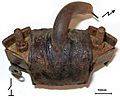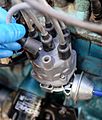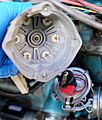Ignition system facts for kids
An ignition system is like the "starter" for an engine. It's the special setup that creates a tiny spark to make a machine's engine, like the one in a car, come to life. Think of it as the match that lights the fire in the engine!
Most ignition systems are a bit different depending on the type of engine. For example, the system in a car engine works differently from the one in a jet engine or a rocket engine. But they all have the same main job: to start the engine by making a spark.
Contents
Why Engines Need a Spark
Engines, especially those in cars and motorcycles, are often called internal combustion engines. This means they burn fuel inside themselves to create power. To make this happen, they need three main things:
- Fuel: Like gasoline or diesel.
- Air: Full of oxygen.
- A spark: To ignite the fuel and air mixture.
Without that spark, the fuel and air just sit there. The ignition system provides that crucial spark at exactly the right moment, making the engine run.
How an Ignition System Works
The main goal of an ignition system is to deliver a very strong electrical spark to the engine's cylinders. Here's a simple way it usually works in many engines:
Creating High Voltage
Engines need a super-strong spark, much stronger than a regular battery can provide. So, the ignition system uses a special part called an ignition coil. This coil takes the low voltage from the car's battery (usually 12 volts) and turns it into thousands of volts! It's like a tiny power booster.
Sending the Spark to the Right Place
Once the high voltage is created, it needs to go to the correct part of the engine at the perfect time.
The Distributor: An Older Way
In older cars, a part called the distributor was used. Imagine the distributor as a spinning arm that directs the high-voltage electricity to each spark plug in the engine, one after another. It makes sure each cylinder gets its spark at the right moment to keep the engine running smoothly.
Modern Electronic Systems
Today, many engines use more advanced electronic ignition systems. These systems don't need a distributor. Instead, a computer controls when and where the sparks happen. Each spark plug might have its own small coil right on top of it, or a few coils might serve several plugs. This makes the system more reliable and efficient.
The Spark Plug: A Tiny Hero
The spark plug is the final piece of the puzzle. It's a small device screwed into each cylinder of the engine. When the high-voltage electricity reaches the spark plug, it jumps across a tiny gap at the end of the plug. This jump creates the actual spark! This spark then ignites the fuel and air mixture, causing a small explosion that pushes a part called a piston, making the engine work.
Types of Ignition Systems
Over the years, ignition systems have become much more advanced.
Magneto Ignition
Some older engines, especially in small machines or airplanes, use a magneto ignition system. A magneto creates its own electricity using magnets and coils, so it doesn't always need a battery to make a spark. It's a self-contained power source for the ignition.
Electronic Ignition
Modern cars almost always use electronic ignition systems. These systems use sensors and a computer to precisely control the timing of the spark. This makes engines more powerful, more fuel-efficient, and produces less pollution. They are very reliable and don't need much maintenance.
Images for kids
See also
 In Spanish: Encendido del motor para niños
In Spanish: Encendido del motor para niños






